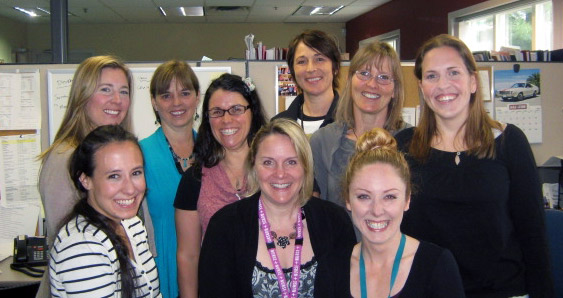Huddles bring time-saving benefits to Squamish home health team
In the midst of discussions about how to work closer with their clients’ family physicians, the Home Health team in Squamish realized there was also an opportunity to work closer with each other. They decided to pick a time every morning for a 15-minute interdisciplinary huddle to discuss care planning for their clients.
“We have a small team that is passionate about caring for clients,” says Rae McDonald, home health team lead for Sea to Sky. “It became clear as we were looking at our individual caseloads that even though the team is co-located in one building, at times we still work in silos.”
And improving communication may start with the team, but it ends with better communication to clients as well.
“When our team is better coordinated it reduces the number of times clients have to tell their story,” says Rae. “Complex clients could have six different members of the team involved in their care. We can talk about who is the best person in the door first, and work together to bring in the other services as necessary. It’s also an opportunity to flag opportunities to book a care conference with a client’s GP to discuss shared care plans.”
During the huddle, the team reviews Squamish General Hospital lists to see if any of their home health clients are in hospital and, if so, to talk about how their intake nurse can liaise with the hospital to share information before they’re discharged. They also look at each discipline’s caseload and their client visits to figure out the pressures of the day and to recognize when more than one team member is involved with the same client.
“We can ask questions like, ‘Who is going to that client’s home that day?’” says Rae. “It gives us the opportunity to talk about going as a team for less interruption to clients.”
The huddles are replacing individual conversations, like a case manager talking to an occupational therapist about a client, and then walking down the hall to share the same information with a palliative coordinator.
Streamlining the conversations was a shift for the home health team. “At first the focus was on getting everyone on board and recognizing the value of a daily huddle, but now the challenge is keeping the huddle to only 15 minutes,” she says.
“I made some PA announcements initially because it was new thing to schedule into everyone’s day,” laughs Rae. “But yesterday I walked around the corner and nine people were ready and waiting for the huddle!”
She feels that the focus is now about fine tuning the process.
It’s only 15 minutes, but already the knowledge exchange happening within the team is making a difference. They have a better understanding of each other’s role, the depth of their involvement, and the integration between primary, community and acute care.
About Home Health Redesign
This story is an example of how the Home Health Redesign project is changing the way we practice across the region. Our interdisciplinary teams are working closer with each other, and with GPs, to provide care that is proactive, driven by client health goals and matched to their needs. For more information on the practice changes teams are adopting, visit the Home Health Redesign project site on VCH Connect.


Mary Ackenhusen
I love your drive to improve how you work together, all to benefit our clients in their homes. Keep up the good work!